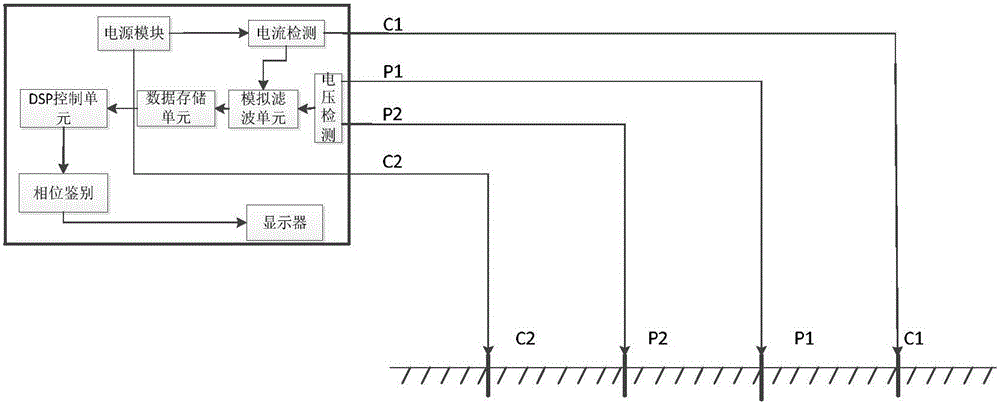A method and device for measuring soil resistivity based on phase recognition
A soil resistivity and phase identification technology, which is used in measuring devices, measuring electrical variables, measuring resistance/reactance/impedance, etc., to achieve the effect of good anti-interference ability, low cost, and strong anti-power frequency interference ability.
- Summary
- Abstract
- Description
- Claims
- Application Information
AI Technical Summary
Problems solved by technology
Method used
Image
Examples
Embodiment 1
[0060] figure 1 Device wiring and working principle block diagram provided for the embodiment of the present invention, figure 2 The layout diagram of the voltage and current electrode leads provided for the embodiment of the present invention is shown in the figure: a method for measuring and testing anti-interference soil resistivity based on phase recognition provided by the present invention includes the following steps:
[0061] S1: Select the soil to be tested and insert the current electrode C1, voltage electrode P1, voltage electrode P2 and current electrode C2 on the surface along a straight line in sequence according to the preset electrode spacing;
[0062] S2: Select the positive-rotating waveform power supply according to the preset frequency, and inject the current signal I into the soil surface to be tested through the current pole C1 and the current pole C2,
[0063] S3: Measure the voltage signal U on the voltage pole P1 and the voltage pole P2;
[0064] S4...
Embodiment 2
[0111] The difference between this embodiment and embodiment 1 is only:
[0112] The schematic diagram of amplitude modulation waveforms of 50Hz and 125Hz voltage signals during actual measurement provided by this embodiment, as shown in Figure 3-4 as shown, image 3 The 125Hz provided for the embodiment of the present invention is 0.1 times the 50Hz signal; Figure 4 The 125Hz signal provided for the embodiment of the present invention is 0.7 times of 50Hz; Figure 5 The 125Hz signal provided for the embodiment of the present invention is twice that of the 50Hz signal;
[0113] This embodiment provides a comparison of the simulation test results considering the mutual inductance and not considering the mutual inductance, such as Figure 6-7 as shown, Figure 6 Consider the comparison of the simulation test results of mutual inductance and no mutual inductance under the 1000Ωm uniform soil resistivity provided for the embodiment of the present invention; Figure 7 Compar...
Embodiment 3
[0149] The difference between this embodiment and embodiment 1 is only:
[0150] The present embodiment provides a soil resistivity measurement device based on phase recognition and anti-lead mutual inductance interference, which mainly includes an auxiliary measurement electrode and a soil resistivity tester. Auxiliary measuring poles include multiple current poles and two voltage poles. The length of each pole is 50-60cm, and the size is ∠20×20×3. The poles are connected to the current port of the tester through wires, and the middle two electrodes are used as voltage electrodes to connect to the voltage port of the tester through wires. The soil resistivity tester consists of a current output module (using high-power power electronic devices as the frequency conversion output power supply, the current output range is 0-6A, with over-current protection function), a current detection module (using Rogowski coil for measurement and matching Industrial-grade A / D converter AD16...
PUM
 Login to View More
Login to View More Abstract
Description
Claims
Application Information
 Login to View More
Login to View More - Generate Ideas
- Intellectual Property
- Life Sciences
- Materials
- Tech Scout
- Unparalleled Data Quality
- Higher Quality Content
- 60% Fewer Hallucinations
Browse by: Latest US Patents, China's latest patents, Technical Efficacy Thesaurus, Application Domain, Technology Topic, Popular Technical Reports.
© 2025 PatSnap. All rights reserved.Legal|Privacy policy|Modern Slavery Act Transparency Statement|Sitemap|About US| Contact US: help@patsnap.com



